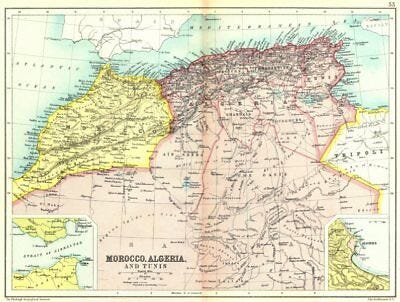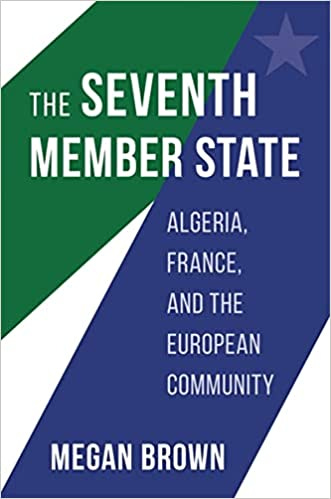Where, and why, is North Africa?
Abdelmajid Hannoum's The Invention of the Maghreb and Megan Brown's The Seventh Member State
How the Middle East as a region came to be, and why it matters, is very much on my mind these days: the centrality of race, the legacies of colonialism, the articulation of political projects around transnational identities, the role of the social sciences in producing and reproducing conceptions of regions. My recent piece in Foreign Affairs (“The End of the Middle East”), for example, questioned the geographical, political and analytical usages of the conventional map of the Middle East as a region. That article built upon a huge 2020 project interrogating transregionalism which I developed with Hisham Aidi and Zachariah Mampilly which primarily focused on North Africa’s place between Africa and the Middle East. That project continued in last year’s Racial Formations collaboration, which continued to explore these themes of transregional comparative research across African and the Middle East. If all goes well (LOL), I’ll be finishing a book on the subject in the next year.
Those questions and themes brought me to two books from outside political science which explored these issues in really provocative ways. Abdelmajid Hannoum’s The Invention of the Maghreb is a tour de force of historical scholarship, showing how French colonialism produced the idea of the Maghreb (North Africa) through deeply racialized repertoires of mapping, ethnography and standardization. Megan Brown’s The Seventh Member State looks at Algeria as part of the negotiations over the European Economic Community. Each of these new books pushes us to rethink our understandings of what regions like “Europe” and “North Africa” really mean - and how deeply racialized their production really was.
The Invention of the Maghreb is one of the most interesting books I’ve read in the past few years, with a theoretically grounded and empirically rich historical narrative which constantly challenges assumptions and raises new questions. Hannoum traces how the concept of the Maghreb came to be defined as fundamentally and essentially different from the Middle East, Africa, and Europe. Much had to do with colonial competition. The French Maghreb had to be essentially different from a British-dominated Middle East, hence the exclusion of Egypt, as well as Italian-colonized Libya. Across his chapters, he shows how French cartographers and ethnographers worked to demonstrate that the differences between the Maghreb and Egypt were so deep that even the Sahara Desert had different physical qualities in the two regions.
Hannoum centers racial formations in how the French distinguished the Maghreb from the rest of West Africa. Africa, by this racialized logic, was defined by blackness; lighter skinned North Africans, particularly Berbers and Arabs, were viewed as something closer to, if not quite equal with, white Europe. The evidence he marshals across these chapters of the fundamental racism in French practice is overwhelming. One of the critically interesting lines he traces across French practice is the ethnographic creation of the Berber as “a new category of the colonial discourse” set in total opposition against “the Arabs” as well as black Africans, wiping out previous ethnographies revealing the diversity of peoples and cultures.
Hannoum traces the creation and naturalization of the concept of the Maghreb from 1830 (the year of Algeria’s conquest) and the 1960s. He engages, of course, with earlier definitions by Ibn Khaldun, the Ottoman Empire, and others, but maintains that there is something fundamentally different about how France created and shaped the region through distinctive colonial technologies and ways of thinking.
France did all this in the interest of governmentability, with imperial control requiring the shaping of culture, identity and practice. In line with work by Timothy Mitchell on Egypt, Hannoum focuses on “the operation of colonial technologies of power.” (The fact that Hannoum barely engages with Mitchell only illustrates the divides between North Africa and Middle East Studies.) Colonial institutions depended not only on brute force, but on the production of knowledge and categorization which rendered societies legible and governable. His book goes into great detail on the contribuitons of the various social and physical science to this project - anthropology, historiography, geography, linguistics, statistics, biology, zoology — all part of the imposition of a colonial modernity rationalizing colonized societies along European terms.
He pays particular attention to mapping as a technology of power: colonial “violence relied on cartographic knowledge and in turn produced a subdued land to be mapped ‘correctly’.” He shows the evolution of the presentation of the Maghreb in these maps: when Algeria is separated from Mali, when from Morocco; when Libya is included and excluded. But ultimately, the defining line is race: “the Maghreb has a geographical limit, the sands, and a racial limit, blackness.” The Sahara - in rather sharp contrast to its actual lived reality - is presented as a “buffer” between black West Africa and the white Maghreb. The legacies of those racial formations continue to shape North African politics to the present day, as essays by Afifa Ltifi, Hisham Aidi, Steven King, Paul Silverstein, Eric Hahonou in our Racial Formations collection demonstrate.
Where Hannoum shows us how the Maghreb came to be differentiated from West Africa and Egypt, Megan Brown’s new book shows another dimension of differentiation, this time from Europe. It seems obvious that Algeria would be part of the negotiations over the 1957 Treaty of Rome establishing the European Economic Community. After all, in 1957 Algeria was still very much a part of France, despite the escalating war of independence. But it hasn’t really been a major part of the historiography or political science of the EEC. Nor, as Megan Brown shows in her fascinating new book, The Seventh Member State, what this actually meant for the meaning of Europe was never entirely clear.
There is, of course, a vast literature on Algeria’s war of independence and its 1962 separation from France - Todd Shepard’s The Invention of Decolonization stands out for me on the French side, and Jeffrey James Byrne’s Mecca of Revolution on the Algerian side. And there’s also, of course, a vast literature on the negotiations over the formation of the European Economic Community; I haven’t kept up with that literature lately, but back when I taught courses on comparative regionalism, Andrew Moravcsik’s The Choice for Europe was my go to text. I don’t remember thinking about Algeria much when reading about European regional integration.
The two literatures, on decolonization and regional integration, seemed to run on parallel tracks. Brown expertly weaves together the two timelines, showing how deeply interwoven the course of Algeria’s war for national independence was with the course of the creation of the European Economic Community. She “calls for a new reading of the spatial boundaries of integrated Europe,” through a detailed reconstruction of the negotiations, agreements, and administrative decisions made by European bureaucrats. Algeria was included by name in the 1957 Treaty of Rome, and European regulations extened to Algeria for five years, until Algeria’s independence. Even after that, the EEC was uncertain about how to deal with Algeria. The idea of Algeria as the “seventh member state” struck Europeans as absurd - despite the fact that for half a decade it had in fact been included.
Algeria’s status within the European Community stood against a broader European debate over “Eurafrica” (the subject of a full chapter in Brown’s book). Four of the six European states negotiating the Treaty of Rome had imperial interests at the time (and Britain’s Empire weighed heavily on French opposition to its inclusion), but Algeria’s status as constitutionally part of France set it apart from the rest of its own Empire — or any other imperial possessions held by its European counterparts. Brown shows how France fought for Algerian inclusion in the EEC both for economic reasons, and as an alternative forum to demonstrate Algeria’s Frenchness as the FLN’s diplomacy made inroads at the United Nations. But as Algeria moved towards independence, French interests changed. As Europe contemplated what to do with independent Algeria, race again weighed heavily in rendering its inclusion “obviously” absurd. As Brown puts it, “European officials not only wrote Algeria out of the EEC, its history as a part of its foundational territory was erased from memory.”
I’m fascinated both by the fluidity of regional identity in the early periods described by both Hannoum and Brown, and by the naturalization of those identities over time. Race, obviously, plays an enormous role in fixing these regional boundaries. So too does colonialism and later great power politics, as well as highly local political dynamics. What’s especially interesting is the role played by the social sciences in producing and reproducing these naturalized conceptions of region. That’s been the subject of a great volume of important research in recent decades, obviously not only in the Middle East-focused literature. It helps us to think through how our own work as political scientists either reproduces or challenges those modes of power today.






